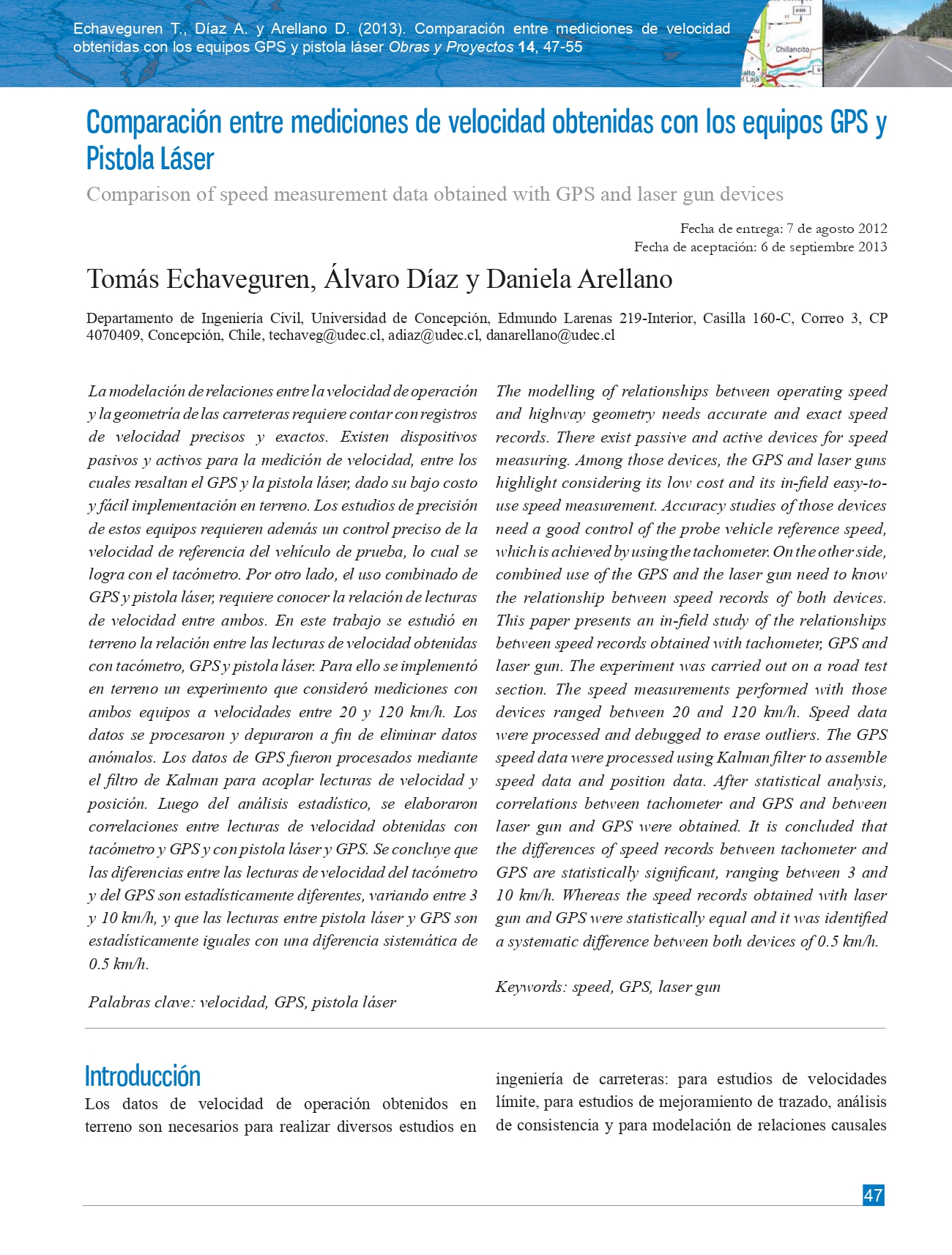Comparison of speed measurement data obtained with GPS and laser gun devices
DOI:
https://doi.org/10.4067/S0718-28132013000200004Keywords:
speed, GPS, laser gunAbstract
The modelling of relationships between operating speed and highway geometry needs accurate and exact speed records. There exist passive and active devices for speed measuring. Among those devices, the GPS and laser guns highlight considering its low cost and its in-field easy-to-use speed measurement. Accuracy studies of those devices need a good control of the probe vehicle reference speed, which is achieved by using the tachometer. On the other side, combined use of the GPS and the laser gun need to know the relationship between speed records of both devices. This paper presents an in-field study of the relationships between speed records obtained with tachometer, GPS and laser gun. The experiment was carried out on a road test section. The speed measurements performed with those devices ranged between 20 and 120 km/h. Speed data were processed and debugged to erase outliers. The GPS speed data were processed using Kalman filter to assemble speed data and position data. After statistical analysis, correlations between tachometer and GPS and between laser gun and GPS were obtained. It is concluded that the differences of speed records between tachometer and GPS are statistically significant, ranging between 3 and 10 km/h. Whereas the speed records obtained with laser gun and GPS were statistically equal and it was identified a systematic difference between both devices of 0.5 km/h.
References
AASHTO (2009). AASHTO guidelines for traffic data programs. American Association of State Highways and Transportation Officials. USA.
Abdelwahab, W.M., Aboul-Ela, M.T. and Morrall, J.F. (1998). Geometric design consistency based on speed change on horizontal curves. Road & Transport Research 7(1), 13-23
Al-Masaied, H.R., Hamed, M. Aboul-Ela, M. and Ghannam, A.G. (1995). Consistency of horizontal alignment for different vehicle classes. Transportation Research Record 1500, 178-183
Bhuyan, P.K. and Rao, K.V.K. (2012). Defining LOS criteria of urban streets using GPS data: k-means and k-medioid clustering in Indian context. Transport 27(2), 149-157. https://doi.org/10.3846/16484142.2012.692354
Cohen, J. (1988). Statistical Power Analysis for the Behavioral Sciences, LA Associates. USA.
Echaveguren, T. y Sáez, J. (2001). Estudio de relaciones velocidad-geometría horizontal en rutas de la VIII región. X Congreso Chileno de Ingeniería de Transporte, 9-12 de Octubre 2001, Santiago, 341-350.
Echaveguren, T. y Basualto, M. (2003). El análisis de aceleraciones en la consistencia de elementos simples de alineamientos horizontales. XI Congreso Chileno de Ingeniería de Transporte, 20-24 de octubre 2003, Santiago, 391-402.
Echaveguren, T. Sepúlveda, P. y Vargas-Tejeda, S. (2011). Evaluación de precisión de mediciones de velocidad de operación en carreteras obtenidas con GPS. XV Congreso Chileno de Ingeniería de Transporte. 3-6 de Octubre 2011. Santiago.
Echaveguren, T. (2012). Análisis de consistencia de caminos bidireccionales usando mediciones continuas de velocidad de operación obtenidas con GPS. Revista Ingeniería de Construcción 27(2), 55-70. https://doi.org/10.4067/S0718-50732012000200004
Echaveguren, T. Arellano, D. y Vargas-Tejeda, S. (2012a). Estudio empírico de velocidad de operación de vehículos pesados en pendientes ascendentes. XVII Congreso Panamericano de Ingeniería de Tránsito, Transporte y Logística. Art #326, Santiago, Chile
Echaveguren, T., Vargas-Tejeda, S. y García, C. (2012b). Estudio de límites de velocidad en curvas horizontales usando aceleraciones laterales. XVI Congreso Argentino de Vialidad y Tránsito. Art #20177, 22-26 octubre, Córdoba
Echaveguren, T. and Vargas-Tejeda, S. (2013). A model for estimating advisory speeds for horizontal curves in two-lane rural roads. Canadian Journal of Civil Engineering 40(12), 1234-1243, 10.1139/cjce-2012-0549. https://doi.org/10.1139/cjce-2012-0549
Kustom Signals (2002). Prolaser®III Lidar system specifications. Kustom Signals Inc. USA.
Li, Y. (2009). Travel time estimation and incident detection using probe vehicles. Use of GPS equipped probe vehicles for traffic data collection. VDM Verlag, Germany
Memon, R., Khaskheli, G.B. and Qureshi, A.S. (2008). Operating speed models for two lane rural roads in Pakistan. Canadian Journal of Civil Engineering 35(5), 443-453. https://doi.org/10.1139/L07-126
Pérez, A.M. García, A. Camacho, F. and D'Attoma, P. (2010). Use of GPS data to model operating speed and deceleration on two-lane rural roads. Transportation Research Record 2171, 11-20
Racelogic (2008). VBOX Mini User Guide. UK.
Schuessler, N. and Axhausen, K.W. (2009). Processing raw data from Global Positioning Systems without additional information. Transportation Research Record 2105, 28-36
Vargas, S. (2008). Definición de umbrales mínimos de resistencia al deslizamiento en pavimentos, en base a un enfoque de demanda y oferta. Tesis Doctoral, Pontificia Universidad Católica de Chile

Downloads
Published
Issue
Section
License
Copyright (c) 2013 Universidad Católica de la Santísima Concepción

This work is licensed under a Creative Commons Attribution-NonCommercial 4.0 International License.







